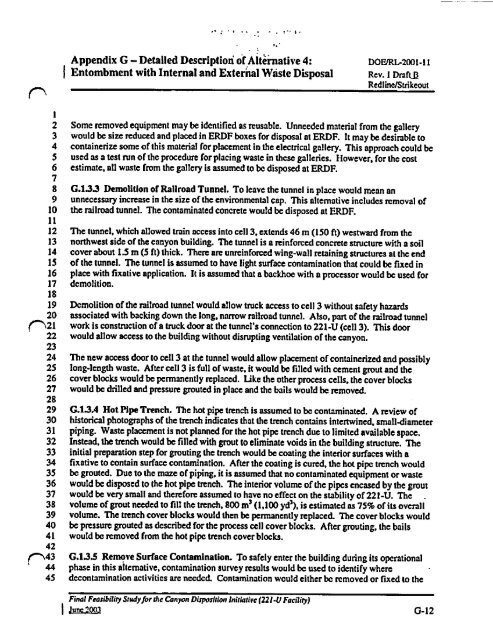View Document Here - Hanford Site
View Document Here - Hanford Site
View Document Here - Hanford Site
You also want an ePaper? Increase the reach of your titles
YUMPU automatically turns print PDFs into web optimized ePapers that Google loves.
... ,.<br />
Appendix G - Detailed DescrIptioti tif Alternative 4: DoEIR1.2001-11<br />
' Entombment with Internal and External Waste Disposal Rev. I Draftli<br />
^ Redline/Strikeout<br />
t '<br />
1<br />
2 Some removed equipment may be identified as reusable. Unneeded material from the gallery<br />
3 would be size reduced and placed in ERDF boxes for disposal at ERDF. It may be desirable to<br />
4 containerize some of this material for placement in the electrical gallery. This approach could be<br />
5 used as a test run of the procedure for placing waste in these galleries. However, for the cost<br />
6 estimate, all waste from the gallery is assumed to be disposed at ERDF.<br />
7<br />
8 G.1.3.3 Demolition or Railroad Tunnel. To leave the tunnel in place would mean an<br />
9 unnecessary increase in the size of the environmental cap. This alternative includes removal of<br />
10 the railroad tunnel. The contaminated concrete would be disposed at ERDF.<br />
11<br />
12 The tunnel, which allowed train access into cell 3, extends 46 m(150 ft) westward from the<br />
13 northwest side of the canyon building. The tunnel is a reinforced concrete structure with a soil<br />
14 cover about 1.5 in (5 ft) thick. There are unreinforced wing-wall retaining structures at the end<br />
15 of the tunnel. The tunnel is assumed to have light surface contamination that could be fixed in<br />
16 place with fixative application. It is assumed that a backhoe with a processor would be used for<br />
17 demolition.<br />
18<br />
19 Demolition of the railroad tunnel would allow truck access to cell 3 without safety hazards<br />
20 associated with backing down the long, narrow railroad tunnel. Also, part of the railroad tunnel<br />
("4\21 work is construction of a truck door at the tunnel's connection to 221-U (cell 3). This door<br />
22 would allow access to the building without disrupting ventilation of the canyon.<br />
23<br />
24 The new access door to cell 3 at the tunnel would allow placement of containerized and possibly<br />
25 long-length waste. After cell 3 is full of waste, it would be filled with cement grout and the.<br />
26 cover blocks would be permanently replaced. l.ike the other process cells, the cover blocks<br />
27 would be drilled and pressure grouted in place and the bails would be removed.<br />
28<br />
29 G.1.3A Hot Pipe Trench. The hot pipe trench is assumed to be contaminated. A review of<br />
30 historical photographs of the trench indicates that the trench contains intertwined, small-diameter<br />
31 piping. Waste placement is not planned for the hot pipe trench due to limited available space.<br />
32 Instead, the trench would be filled with grout to eliminate voids in the building structure. The<br />
33 initial preparation step for grouting the trench would be coating the interior surfaces with a<br />
34 fixative to contain surface contamination. After the coating is cured, the hot pipe trench would<br />
35 be grouted. Due to the maze of piping, it is assumed that no contaminated equipment or waste<br />
36 would be disposed to the hot pipe trench. The interior volume of the pipes encased by the grout<br />
37 would be very small and therefore assumed to have no effect on the stability of 221-U. The<br />
38 volume of grout needed to fill the trench, 800 tns (1,100 yds), is estimated as 75% of its overall<br />
39 volume. The trench cover blocks would then be permanently replaced. The cover blocks would<br />
40 be pressure grouted as described for the process cell cover blocks. After grouting, the bails<br />
41 would be removed from the hot pipe trench cover blocks.<br />
42<br />
n43 G.13.5 Remove Surface Contamination. To safely enter the building during its operational<br />
44 phase in this aitemative, contamination survey results would be used to identify where<br />
45 decontamination activities are needed. Contamination would either be removed or fixed to the<br />
Final Feasibility Study jor the Canyon D'uposlrion lnitiative (211-U Facility)<br />
Luas:.401 G-12

















